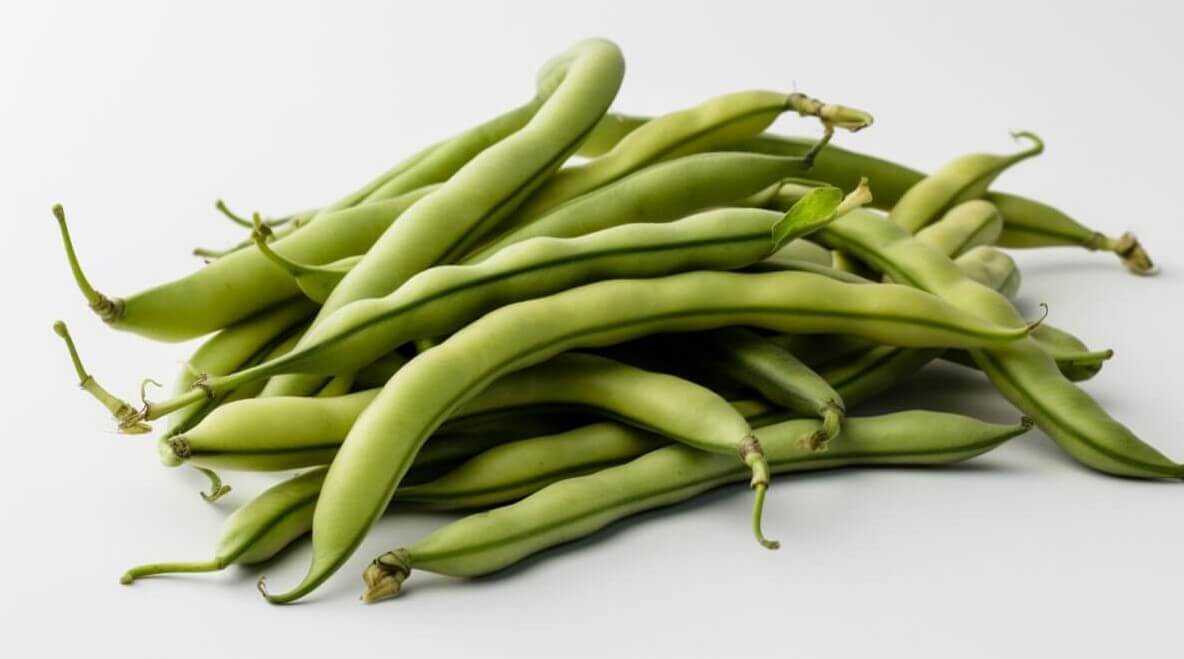Would you prefer to listen to a short podcast discussion about this article? Click on the audio below.
Runner beans are a staple in many gardens – and for good reason. They are tasty, nutritious and easy to grow. Growing your own runner beans can be a rewarding experience, as you get to watch them grow from seed to harvest, and enjoy the satisfaction of serving up your own home-grown produce.
However, many people are unsure about how to grow these beans successfully. In this article, we will provide you with a step-by-step guide on how to grow your own runners, covering everything from choosing the right site to caring for your plants and dealing with common problems and pests.
Table of Contents
1. Choosing the Right Site for Your Beans
If you’re planning to grow your own runner beans, the first step is to choose a good location for your plants. Here are some important factors to consider when selecting a site for your runner beans.
Understanding the Light Requirements of Your Beans
Runner beans need plenty of sunlight to grow and produce a bountiful crop. Look for a site that receives at least 6 hours of direct sunlight each day.
Considering Soil and Drainage
The plants prefer well-draining soil that’s rich in organic matter. Avoid planting in heavy clay soils that are prone to waterlogging, as this can lead to root rot. If your soil doesn’t drain well, consider building raised beds or adding organic matter to improve soil structure.
Choosing a Sheltered Location
Runner beans can be susceptible to wind damage, so it’s a good idea to choose a sheltered location for your plants. Look for a spot that’s protected by a fence, wall, or hedge, or consider using stakes or trellises to support your plants and prevent them from toppling over in strong winds.
2. Preparing the Soil for Your Plants
Once you’ve chosen a site for your plants, it’s time to prepare the soil. Proper soil preparation is essential for healthy plant growth and a bountiful harvest.
Clearing the Plot and Removing Weeds
Before planting, clear the plot and remove any weeds or debris. This will help to prevent competition for nutrients and water and create a clean space for your plants to grow.
Adding Organic Matter to Improve Soil Health
Adding organic matter, such as compost or well-rotted manure, is a great way to improve soil health and fertility. This will help your beans to grow strong and healthy and produce a bountiful crop.
Testing Soil pH and Adjusting as Needed
Runner beans prefer slightly acidic soil with a pH of around 6.0-6.8. Test your soil pH using a soil testing kit and adjust as needed with lime or sulfur to create an optimal growing environment for your plants.
3. Selecting the Perfect Variety for Your Garden
Choosing the right variety is key to a successful harvest. Here’s what to consider when selecting a variety for your garden.
Determining Your Preferred Bean Type
Runner beans come in a variety of types, including dwarf, climbing, and pole beans. Consider your available space and growing needs when selecting a type of runner bean.
Considering Seed Varieties and Characteristics
When selecting a specific variety of runner bean, consider factors like colour, size, and flavour. Some popular runner bean varieties in the UK include ‘Painted Lady,’ ‘Scarlet Emperor,’ and ‘White Lady.’
Buying High-Quality Seeds from Reputable Suppliers
To ensure the best possible harvest, buy high-quality seeds from reputable suppliers. Look for seeds that have been certified by the Royal Horticultural Society (RHS) or other reputable organizations to guarantee their quality and germination rate.
4. Sowing and Planting Your Runner Beans
Now that you’ve selected the perfect variety of runner bean for your garden, it’s time to sow and plant your seeds. Here are some tips for getting started.
Starting Seeds Indoors
If you’re starting runner bean seeds indoors, sow them in individual pots filled with seed compost in early spring. Place the pots in a warm, bright location and keep the soil moist until the seeds germinate.
Direct Sowing in the Garden
For direct sowing in the garden, wait until the soil has warmed up in late spring or early summer. Sow seeds directly into the soil at a depth of 2-3 cm and water well.
Planting Seedlings Outdoors
If you’ve started your runner bean seeds indoors, you can transplant them outdoors once they have developed 2-3 sets of true leaves. Plant them in the prepared soil at a spacing of around 30 cm apart, and provide support with stakes or trellises as needed.
5. Caring for Your Plants
Growing your own runner beans can be a rewarding and satisfying experience. However, it takes some dedication and care to ensure that your plants thrive. Here are some tips to care for your runner bean plants:
Providing Proper Support and Trellising
Runner beans are climbers and need support as they grow. Use a trellis or stakes to support the plants and prevent them from falling over. Make sure the support is sturdy enough to withstand strong winds.
Watering and Fertilizing Regularly
Runner beans require regular watering to keep the soil moist. Make sure the soil is well-drained to prevent waterlogging, which can lead to root rot. Fertilize your plants every two weeks with a balanced fertilizer to encourage growth and yield.
Pruning and Pinching Back to Encourage Growth
Pinch back the tips of your runner bean plants once they reach the top of the trellis to encourage bushy growth and more runners. Prune any yellow or damaged leaves as well as any runners that are not producing beans to redirect the plant’s energy towards the healthy runners.
6. Harvesting and Storing Your Runner Beans
Once your runner bean plants start to produce beans, it’s time to start harvesting them. Here are some tips to help you harvest and store your runner beans:
Determining When Your Runner Beans Are Ready to Harvest
Runner beans are ripe for harvesting when they are long and plump. They should snap easily when bent. Make sure to harvest your beans regularly to encourage further production.
Harvesting and Handling Your Runner Beans Properly
When harvesting, use a sharp knife or scissors to avoid damaging the plant. Handle your beans gently to avoid bruising or snapping. Rinse the beans in cold water and dry them thoroughly.
Storing Your Beans for Later Use
Store your runner beans in a plastic bag or container in the fridge. They should last for up to a week. You can also blanch and freeze your beans for later use by boiling them for 2-3 minutes, cooling them in ice water, and then storing them in an airtight container in the freezer.

7. Dealing with Common Runner Bean Problems and Pests
While runner beans are relatively easy to grow, they can attract pests and diseases. Here’s how to prevent and treat common issues:
Identifying Common Pests and Diseases
Common pests that affect runner beans include aphids, whiteflies, and spider mites. Diseases such as rust, grey mould, and bacterial blight can also be a problem.
Preventing and Treating Health Issues with Your Runner Beans
Prevent pests and diseases by keeping your plants healthy and well-watered. Remove any dead or diseased plant material from the area. If you do see signs of pest or disease infestation, treat the plants with insecticidal soap or a fungicide.
Using Natural Pest Control Methods to Keep Your Runner Beans Healthy
Consider using natural pest control methods to protect your runner beans. Companion planting with flowers such as marigolds, nasturtiums, and lavender can help repel pests. You can also use garlic spray or soapy water to deter pests. Growing your own runner beans in the UK can be a fun and rewarding experience. With proper preparation, care, and attention, you can have a successful harvest of delicious and nutritious beans. By following the tips and techniques outlined in this article, you can start your own runner bean garden and enjoy the fresh taste of home-grown produce. Happy gardening!
FAQ
1. When is the best time to plant runner beans in the UK?
The best time to plant runner beans in the UK is from mid-May to early July. Planting earlier than mid-May can result in poor germination, and planting later than early July means the plants may not have enough time to mature before the weather turns cooler.
2. How often should I water my runner beans?
Runner beans require regular watering, especially during dry spells. Aim to water deeply once a week, rather than shallow watering more frequently. Make sure the soil is evenly moist but not waterlogged, as this can lead to root rot.
3. Can I save seeds from my runner beans to use next year?
Yes, you can save seeds from your runner beans to use next year. Allow the pods to dry on the plant until they turn brown and papery. Remove the beans from the pods and store them in a cool, dry place until you are ready to plant them next year.
4. How can I keep pests from damaging my runner bean plants?
There are a few natural pest control methods you can use to keep pests from damaging your runner bean plants. These include companion planting with marigolds or other plants that repel pests, using netting or fleece to keep insects away, and spraying a mixture of water and dish soap on your plants to deter pests.
Here’s a great explanation video from Love The Garden
If you are keen on organic gardening, check out The Soil Association website
If you need any further information or assistance with this article, don’t hesitate to Contact Us




















